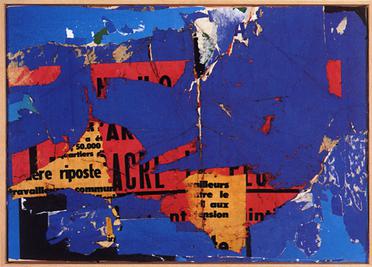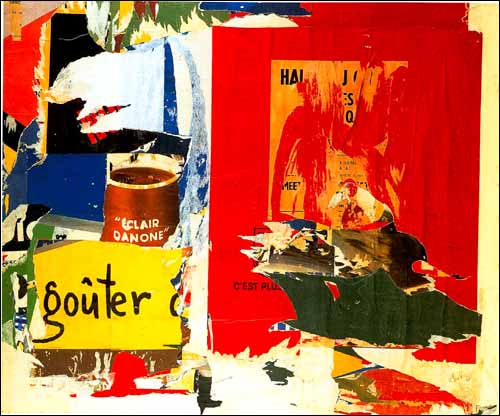Martial Raysse is a French artist born in Golfe-Juan on
February 12, 1936. He lives in Issigeac - France. Raysse was born in a
ceramicist family in Vallauris and began to paint and write poetry at age 12.
After studying and practising athleticism at a high level, he began to
accumulate rubbish odds and ends that he preserved under plexiglas. In 1958, he
exhibited some of his paintings with Jean Cocteau at Galerie Longchamp.
Fascinated by the beauty of plastic, he plundered
low-costs shops with plastic items and developed what became his "vision
hygiene" concept; a vision that showcases consumer society. This work
received attention and critical praise in 1961 and at a commercial gallery in
Milan, his exhibition sold out 15 minutes before the opening. Raysse then
traveled to the United States to get involved with the pop art scene in New
York City.
In October 1960, Martial Raysse, together with Arman,
Yves Klein, François Dufrêne, Raymond Hains, Daniel Spoerri, Jean Tinguely,
Jacques Villeglé and the art critic and philosopher Pierre Restany founded the
group Nouveaux Réalistes. The group was later joined by César, Mimmo Rotella,
Niki de Saint Phalle and Christo. This group of artists defined themselves as
bearing in common a "new perspective approaches of reality". Their
work was an attempt at reassessing the concept of art and the artist in the
context of a 20th Century consumer society by reasserting the humanistic ideals
in the face of industrial expansion.
Nouveau réalisme (new realism) refers to an artistic
movement founded in 1960 by the art critic Pierre Restany and the painter Yves
Klein during the first collective exposition in the Apollinaire gallery in
Milan. Pierre Restany wrote the original manifesto for the group, titled the
"Constitutive Declaration of New Realism," in April 1960,
proclaiming, "Nouveau Réalisme—new ways of perceiving the real."
This joint
declaration was signed on October 27, 1960,
in Yves Klein's workshop, by nine people: Yves Klein, Arman, Martial Raysse,
Pierre Restany, Daniel Spoerri, Jean Tinguely and the Ultra-Lettrists, Francois
Dufrêne, Raymond Hains, Jacques de la Villeglé; in 1961 these were joined by
César, Mimmo Rotella, then Niki de Saint Phalle and Gérard Deschamps. The
artist Christo showed with the group.
Contemporaries of American pop art, and often conceived
as its transposition in France, new realism was, along with Fluxus and other
groups, one of the numerous tendencies of the avant-garde in the 1960s. It was
dissolved in 1970.
The first exposition of the nouveaux réalistes took place
in November 1960 at the Paris "Festival d'avant-garde." This
exposition was followed by others: in May 1961 at the Gallery J. in Paris;
International Exhibition of the New Realists, a survey of contemporary American
Pop Art and the Nouveau Réalisme movement at the Sidney Janis Gallery in New
York at the end of 1962; and at the Biennale of San Marino in 1963 (which would
be the last collective show by the group). The movement had difficulty
maintaining a cohesive program after the death of Yves Klein in June, 1962.
The members of the nouveaux réalistes group tended to see
the world as an image from which they could take parts and incorporate them
into their works—as they sought to bring life and art closer together.
They
declared that they had come together on the basis of a new and real awareness
of their "collective singularity", meaning that they were together in
spite of, or perhaps because of, their differences. But for all the diversity
of their plastic language, they perceived a common basis for their work; this
being a method of direct appropriation of reality, equivalent, in the terms
used by Pierre Restany, to a "poetic recycling of urban, industrial and advertising
reality".
Thus the nouveaux réalistes advocated a return to
"reality" in opposition to the lyricism of abstract painting. They
also wanted to avoid what they saw as the traps of figurative art, which was
seen as either petty-bourgeois or as Stalinist socialist realism. Hence the
Nouveau Réalistes used exterior objects to give an account of the reality of
their time. They were the inventor of the décollage technique (the opposite of
collages), in particular through the use of lacerated posters—a technique
mastered by François Dufrene, Jacques Villeglé, Mimmo Rotella and Raymond
Hains. Often these artists worked collaboratively and it was their intention to
present their artworks in the city of Paris anonymously.
The term "new realism" was first used in May
1960 by Pierre Restany, to describe the works of Arman, François Dufrêne,
Raymond Hains, Yves Klein, Jean Tinguely and Jacques Villeglé as they exhibited
their work in Milan. He had discussed this term before with Yves Klein (who
died prematurely in 1962), who preferred the expression "today's
realism" (réalisme d'aujourd'hui) and criticized the term "New."
After the first "Manifesto of New Realism," a second manifesto,
titled "40° above Dada" (40° au-dessus de Dada) was written between
17 May and 10 June 1961. César, Mimmo Rotella, Niki de Saint-Phalle (then
practicing "shooting paintings") and Gérard Deschamps then joined the
movement, followed by Christo in 1963. Klein, however, started to distance himself
from the group around 1961, disliking Restany's insistence on a Dadaist
heritage.
Nouveau réalistes made extensive use of collage and
assemblage, using real objects incorporated directly into the work and
acknowledging a debt to the readymades of Marcel Duchamp. But the New Realism
movement has often been compared to the Pop Art movement in New York for their
use and critique of mass-produced commercial objects (Villeglé's ripped cinema
posters, Arman's collections of detritus and trash), although Nouveau Réalisme
maintained closer ties with Dada than with Pop Art.







%20-1.jpg)
